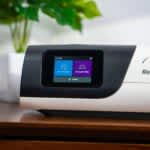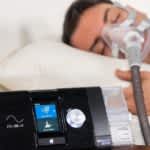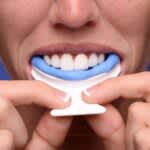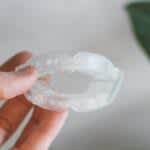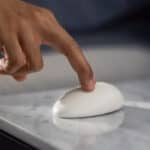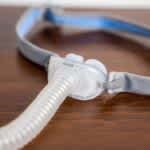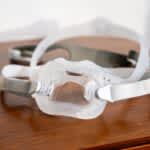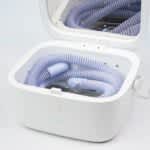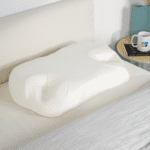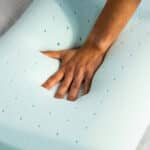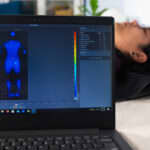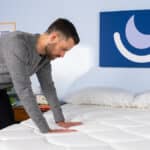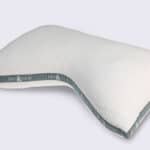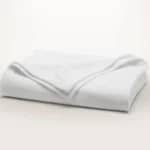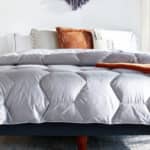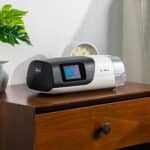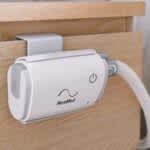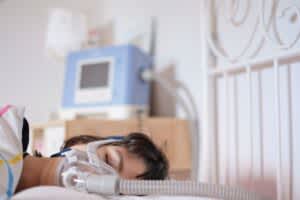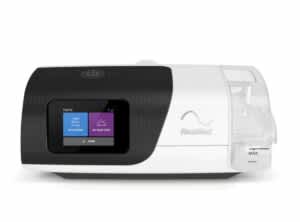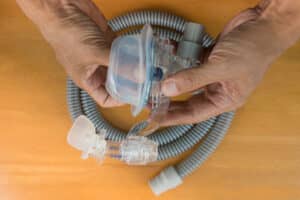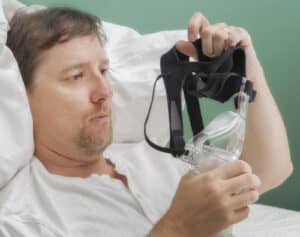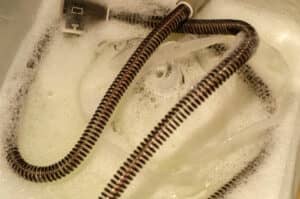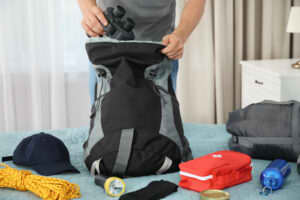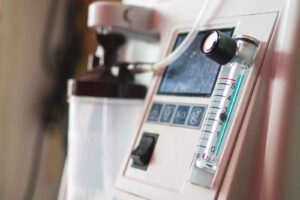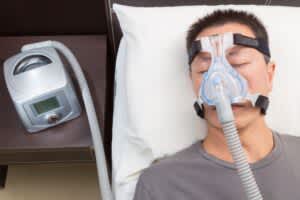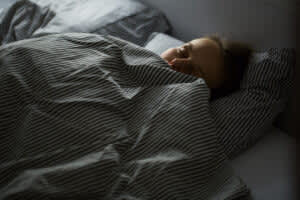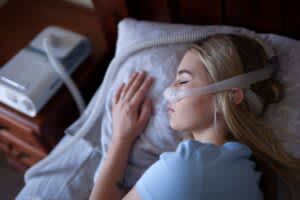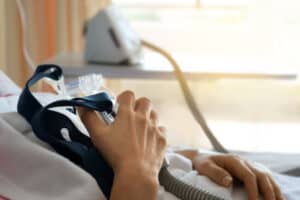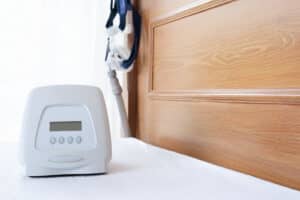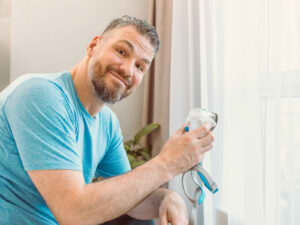Automatic positive airway pressure (APAP) machines are an increasingly popular choice for treating obstructive sleep apnea (OSA), a condition characterized by shallow breathing or brief pauses in breathing during sleep.
An APAP machine adapts to a user’s breathing patterns throughout the night and may provide a more comfortable experience for people who have difficulty tolerating traditional continuous positive airway pressure (CPAP) therapy.
We explain the advantages of APAP therapy, how it differs from CPAP therapy, and what to consider when buying an APAP machine.
What Is an APAP Machine?
Also known as an auto-adjusting CPAP or an auto-CPAP, an APAP machine is a type of positive airway pressure (PAP) device that delivers pressurized air via a hose and a mask.
While a fixed-pressure CPAP machine supplies a consistent, steady stream of air, an APAP machine uses an algorithm to vary the air pressure based on the sleeper’s needs.
By detecting when a person’s breathing slows or stops and responding with an increase in air pressure, APAP machines can resolve sleep apnea events when they occur while providing gentler airflow at other times.
Why Use an APAP Machine?
An APAP machine may be recommended for certain people who are likely to benefit from its ability to automatically adjust air pressure levels.
- People who find CPAP therapy uncomfortable: Some people find fixed-level CPAP therapy difficult to get used to, particularly for those with higher pressure requirements.
- Sleepers with changing pressure needs: A person’s sleep apnea symptoms may vary from night to night or over time due to factors like changes in sleep position, alcohol intake, nasal congestion levels, or fluctuating body weight.
- Pregnant people: People who are pregnant may find that their sleep apnea symptoms worsen over the course of their pregnancy. An APAP machine may be a better choice to avoid additional titration studies at a sleep lab to dial in an appropriate pressure setting on a fixed-level CPAP device.
In general, if a person needs high air pressure on some nights, but only a small amount of pressure other times, then an APAP machine may be preferable. However, there are some groups of people who are not good candidates for an APAP device.
APAP therapy is generally not recommended for people diagnosed with central sleep apnea (CSA), a condition involving breathing disruptions caused by the brain failing to send signals to the muscles that control respiration. This is due to APAP algorithms being less adept at detecting central apneas when compared to other PAP devices like adaptive servo-ventilation (ASV) machines and bilevel positive airway pressure (BiPAP) devices used in spontaneous-timed mode.
Additionally, people who are more prone to air leaks during PAP therapy due to their facial structure or other factors are less likely to be prescribed an APAP machine.
What Are the Benefits of an APAP Machine?
Increased therapy comfort is a potential benefit of APAP machines. Unlike a CPAP machine, which is set to one prescribed air pressure level, APAP devices are programmed with a prescribed pressure range. Using built-in sensors and sophisticated algorithms, APAP machines are designed to deliver the lowest pressure level needed to keep the user’s airway open during sleep apnea events.
Some APAP machines include a feature known as expiratory pressure relief. This optional comfort setting gently lowers the air pressure level during exhalation, which may benefit people who find it uncomfortable to exhale against higher pressure.
Titration Methods: CPAP vs. APAP
Following a diagnosis of obstructive sleep apnea, a doctor may recommend a CPAP or APAP machine depending on the results of a sleep study. For people prescribed a CPAP machine, the next step in the process is to attend an in-person titration study at a sleep clinic, where an appropriate fixed pressure setting will be determined.
Since APAP machines can essentially auto-titrate in real time, people who are a suitable fit for this type of device may be able to forgo a visit to a sleep lab. This scenario may be particularly appealing to someone who has done an at-home sleep apnea test instead of an in-person sleep study, since they could potentially receive a therapy device without multiple trips to a sleep clinic.
However, not everyone who receives an OSA diagnosis is a suitable candidate for an APAP machine. Additionally, the results of an at-home sleep apnea test may be inconclusive and may require additional testing in a lab-based setting.
How to Choose an APAP Machine
Most brands that sell CPAP machines also offer APAP models. Things to consider when shopping for the right APAP machine include cost, comfort features, and ease of data management.
Prescription Information
You need a prescription to buy an APAP or CPAP machine. A sleep apnea diagnosis generally requires a sleep study either at a sleep clinic or at home.
Cost and Insurance Coverage
If paying out of pocket, the average APAP machine costs between $600 and $1,600, which is slightly higher than the typical CPAP price-point.mMany insurance plans cover at least part of the cost of an APAP machine. Contact your insurance provider to learn specific coverage details.
Data Capabilities
Most insurance providers require proof that you’ve been using your PAP machine as instructed by your doctor. To make the compliance process easier, modern APAP and CPAP machines track usage data.
Many machines have built-in cellular modems that let users wirelessly upload data to a cloud-based platform. Models that lack cellular connectivity generally come with an SD card. In the latter scenario, owners may need to invest in an SD card reader to upload the data to their computer. Alternatively, the card may need to be periodically mailed to a doctor or dropped off at their office in person.
Features
Many APAP machines are equipped with features designed for increased therapy comfort. For example, some devices include a built-in humidifier with a removable water chamber to add moisture to the pressurized air.
Another common feature is a ramp setting. This feature starts therapy at a lower pressure level to let users ease into their nightly therapy. Some models include a pressure relief system that gently lowers the air pressure level when the sleeper exhales.
Preventing Common APAP Machine Issues
APAP machines present many of the same challenges as CPAP devices, though there are steps users can take to mitigate comfort issues and therapy side effects.
- Poor mask fit: If an APAP mask doesn’t fit well, it can lead to both discomfort and ineffective treatment. Work with your doctor to learn which mask style is the best choice and how to select the right fit.
- Dryness: The airflow of PAP machines can lead to dryness or irritation in the nose or mouth. Proper mask fit combined with a built-in heated humidifier is recommended to reduce these side effects.
- Congestion: A stuffy nose can interfere with breathing and make PAP therapy uncomfortable for some people. Nasal sprays or allergy medications may help prevent this issue. Some people with nasal congestion prefer a full-face mask that covers both the nose and mouth. A visit to a primary care doctor or an ear, nose, and throat specialist (ENT) can be helpful, especially if this is an ongoing issue.
Speak with your doctor if you encounter any difficulties when using your APAP machine or if you experience any side effects. They can offer recommendations to improve your nightly therapy.
References
Ask the Sleep Doctor
Have questions about sleep? Submit them here! We use your questions to help us decide topics for articles, videos, and newsletters. We try to answer as many questions as possible. You can also send us an email. Please note, we cannot provide specific medical advice, and always recommend you contact your doctor for any medical matters.

